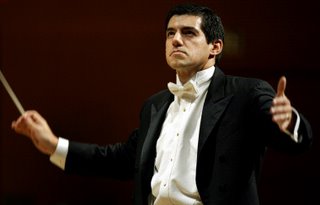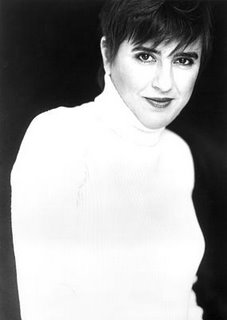 The National Symphony Orchestra’s administration can’t be envied the job of planning for an exciting Shostakovich Festival with the starriest soloists and a conductor much beloved in Washington (and some ‘DSCH’ credentials, to boot) – and then having to sell the audience Pinchas Zukerman (last week) and Nadja Salerno-Sonnenberg (Thursday and Friday night; Yo-Yo Ma’s performance on Saturday is still on). Not that these artists are to be scoffed at, but the whole affair could still be considered ‘disappointment-management’. Needless to say, had Martha Argerich appeared this Thursday, the Kennedy Center’s Concert Hall would not have shown so many empty seats.
The National Symphony Orchestra’s administration can’t be envied the job of planning for an exciting Shostakovich Festival with the starriest soloists and a conductor much beloved in Washington (and some ‘DSCH’ credentials, to boot) – and then having to sell the audience Pinchas Zukerman (last week) and Nadja Salerno-Sonnenberg (Thursday and Friday night; Yo-Yo Ma’s performance on Saturday is still on). Not that these artists are to be scoffed at, but the whole affair could still be considered ‘disappointment-management’. Needless to say, had Martha Argerich appeared this Thursday, the Kennedy Center’s Concert Hall would not have shown so many empty seats.That the conductor for the current run of concerts is the fairly unknown (his extensive credentials notwithstanding) Miguel Harth-Bedoya probably didn’t help. What did help was listening to the music itself! Ravel’s Rapsodie espagnol was played more than just expertly by the NSO. Under Maestro Harth-Bedoya’s guide there was much caressing of the music, a fleetness even amidst bombast, and a notably impressive use of the entire dynamic spectrum; from the very soft (challenging), to thundering (easy), and especially every shade in between (difficult).
 Tchaikovsky’s Violin Concerto was next in line – with Nadja Salerno-Sonnenberg at the wheel. During the orchestral opening she seemed to prepare for her entry like a boxer before emerging from his corner. Unlike as is expected from a boxer (except Ali, perhaps), she started feathery, with deliberate but light punctuations. From thereon it shifted to ‘very fast’ (if not perfectly clean) and back to deliberate.
Tchaikovsky’s Violin Concerto was next in line – with Nadja Salerno-Sonnenberg at the wheel. During the orchestral opening she seemed to prepare for her entry like a boxer before emerging from his corner. Unlike as is expected from a boxer (except Ali, perhaps), she started feathery, with deliberate but light punctuations. From thereon it shifted to ‘very fast’ (if not perfectly clean) and back to deliberate. For better or worse, there is scarcely a work where Ms. Sonnenberg doesn’t leave her very individualistic footprints… not unlike a boy who feels compelled to carve his initials in every tree’s bark he sees, or a dog… never mind. This can detract at times, but it can also be used to generate excitement, especially in as often heard a work as the Tchaikovsky concerto. Many ears are exhilarated, a few others may experience motion sickness. The near-unanimous, conscientious, and extensive applause after a furious first movement (Allegro moderato, not very “moderato”), which is of course designed to elicit applause, clarified the distribution between those two groups. The finale (Allegro vivacissimo), attacka from the Canzonetta: Andante (soft shades and nearly lyrical) brought the house down.
If the crowd had found its star for the night, there was more to offer still. In Silvestre Revueltas’ La noche de los mayas there came a work that could (or even should) have stolen the show. Briefly introduced by the Peruvian maestro, the four-partite work blistered and gurgled around the audience’s ears in great style.
The first movement, Noche de los mayas (Molto sostenuto), is looming and threatening in an earthy, powerful way. It addresses the spiritual, if not actual, strength of what remains of Mayan culture. The second movement, Noche de jaranas (Scherzo) brings an almost frivolously light-hearted Spanish dance into contrast with a current that seems to undermine (but never topple) the percussion-happy celebratory mood. Lyrical, broad, and solidly European in character – not without harmonic hints to its 1930’s vintage – the third movement (Noche de Yucatán (Andante espressivo)) enters – when a wistful, native Indian mood sets in, picking up a storm for its headlong entry into the fourth movement. Noche de encantamiento (Tema y variaciones) is its title and here things quickly lead to a percussion cadenza that predates the tam-tam, conga, and bongo frenzy that more recent Latin American composers can’t seem to resist. It demonstrated, through sheer quality, that element’s usually shallow and cartoonish employment by Revuelta’s successors. Brass-fanfares beef the movement up to make it a harrowing, wild-eyed rush of a composition.
Composed as a film score to Chano Urueta’s 1939 film of the same name and arranged into a concert suite by José Ives Limantour (with the added cadenza by Enrique Arturo Diemecke, which is based on other Revueltas compositions), this is not celluloid background music but on equal footing with anything that might be presented in concert halls as ‘absolute music’. With effort and skill in ample supply, the NSO allowed Harth-Bedoya to lead them in a terrific and terribly satisfying performance much deserving to be heard in today’s performance at 7PM (no matter how you might feel about Tchaikovsky).